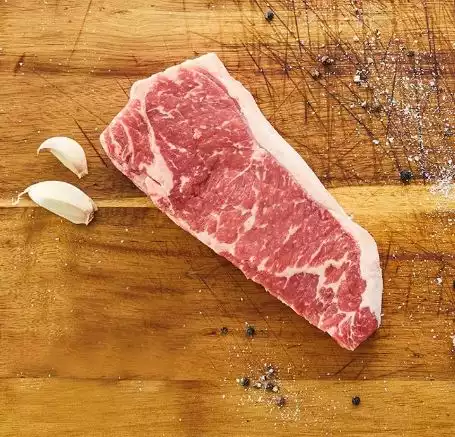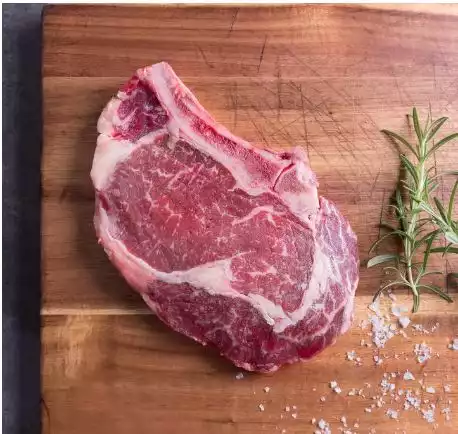- Where to Buy Meat Online: 12 Best Meat Delivery Services - April 12, 2023
- Stock Yards Review: Will Their Meat Meet Your Expectations? - April 12, 2023
- Chicago Steak Delivery Review: A Complete Guide - April 12, 2023
When you’re comparing two steaks that clearly look very different, it’s not difficult to see those differences. It may still take some additional studying to figure out how they differ on the inside, but you can tell at first glance that you’re dealing with two different cuts.
However, when you’re looking at two similar cuts side by side, like the New York strip and the ribeye, it can be tough to tell the difference. In fact, they are both very similar, so you may need a quick lesson on the differences, so you can make an educated order the next time you go to the steak house.
Main Differences Between New York Strip and Ribeye
The main differences between the New York Strip and ribeye are:
- New York strip has a very thick and visible band of fat running down one side, whereas the ribeye has strips of fat around all outer edges.
- New York strip can be a tricky cut to cook properly, whereas the ribeye’s marbling makes it very forgiving and easy to cook, even if you overcook it.
- New York strip is generally served without the bone, whereas a ribeye can be served either with or without the bone.
- New York strip is a bit chewier, whereas the ribeye’s pervasive fat content throughout makes it more tender.
- New York strip is cut from the loin section at the rear of the longissimus dorsi muscle and has a tighter texture with less marbling, whereas the ribeye is cut from the rib section at the front of the longissimus dorsi muscle and has a more tender texture with more marbling.
New York Strip
The New York strip comes from a muscle that runs along the rib section, referred to as the loin. It’s the same place where ribeyes and filet mignons are cut from. However, the New York strip’s texture is tighter and it has less fat than a ribeye.
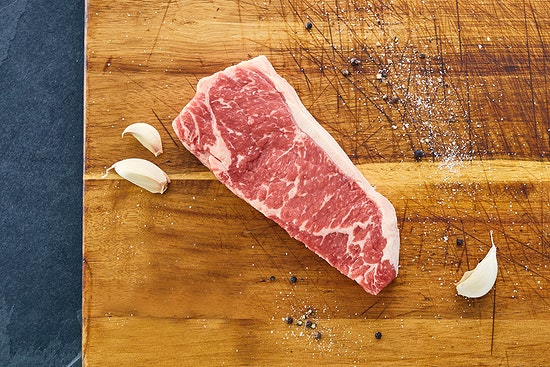
You’ll also find New York strips masquerading under the names ambassador steak, Kansas City strip, Omaha strip, strip loin steak, or club steak. While many people say this cut originated in New York, I like to say Kansas City perfected it. But, I’m a bit biased.
The name isn’t what makes it great anyway. It’s the bold, beefy flavor that you’ll fall in love with instantly.
Find this steak here: New York Strip!
Looking for a luxurious steak dinner? Look no further than our New York Strip Steak. This cut comes from the top of the striploin and is known for its intense flavor and tender texture.
Appearance
While the New York strip looks similar to the ribeye, a New York strip never has a bone. It also has much less marbling throughout, although it does have some. It’s a thick cut of meat with a single strip of fat running down one side.
You can almost immediately identify a strip by this, well, strip of fat.
Texture
A New York strip tends to be a chewy piece of meat. While it has some marbling throughout, it doesn’t have nearly as much as other cuts, and it’s a well-used piece of muscle, causing some toughness.
Taste
While this toughness can turn some people off to eating it, when it’s cooked properly, the flavor is excellent. A New York strip has a bold flavor that explodes in your mouth. It’s savory and robust. You need nothing more than salt and pepper to season it.
Cost
While a strip steak costs quite a bit more per pound than most other cuts (with only one or two exceptions), it’s one of the most savory and delicious options around. If you haven’t tried one yet, you’ll be delighted by the explosion of flavor that more than makes up for the cost.
Portion size
New York strips range in size from 12-16 ounces, but you can sometimes get them as small as 8 or 10 ounces. They’re generally cut between one and two inches thick. There’s a prevailing theory that Kansas City strips are smaller, while New York strips are larger.
Whether this is true or not really doesn’t matter. These cuts are identical.
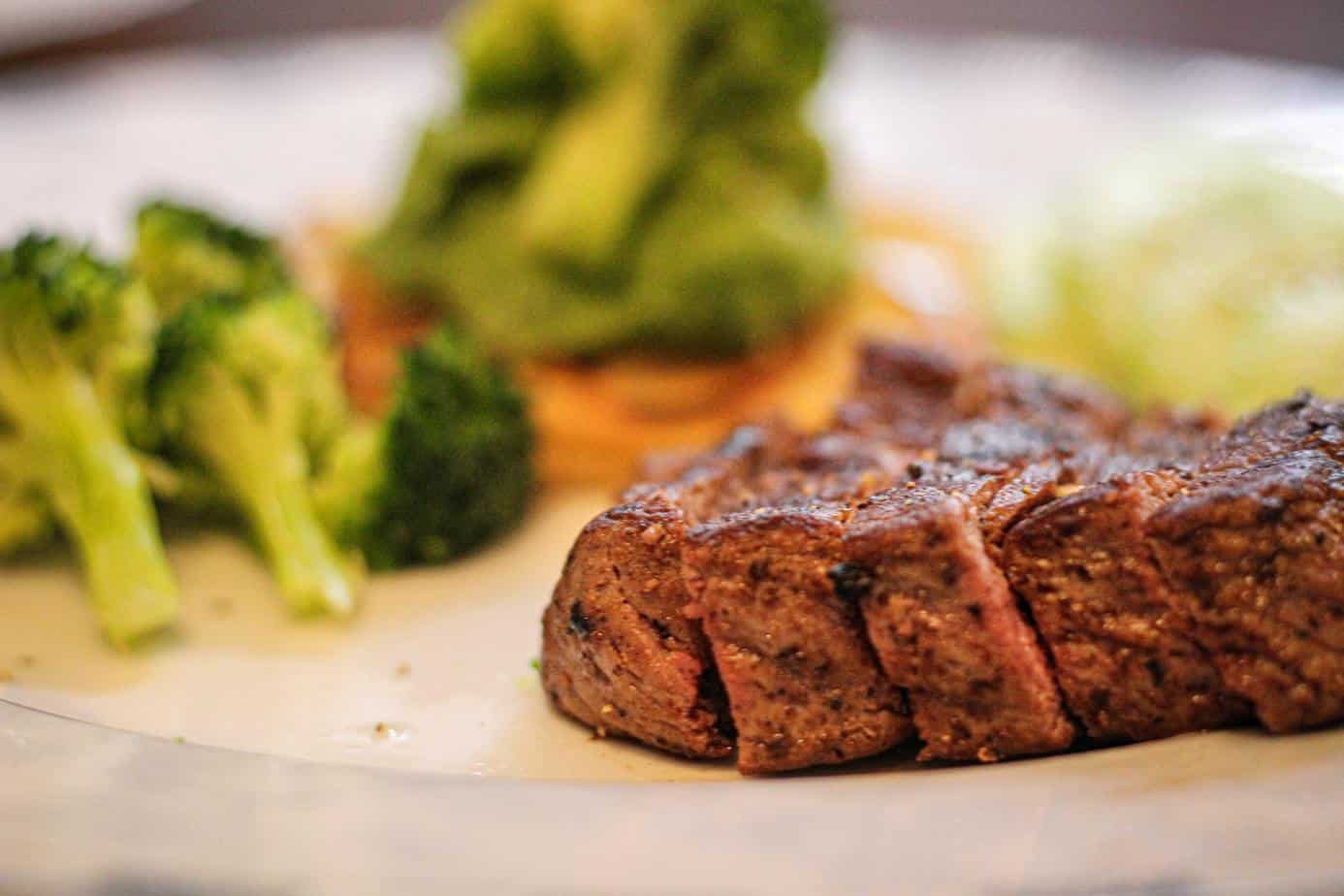
Grilling prep
Just like most other cuts of beef, you’ll want to remove it from the refrigerator about 20 minutes before putting your New York strip on the grill. It takes some of the chill away and allows it to cook more evenly, preserving the intense flavor.
While you can trim some of the fat if you feel like it may flare, you don’t want to cut it completely away, because this will add to the juicy flavor of the final steak.
You can use either gas or charcoal to cook your steak, just as long as you use a two-zone cooking method. New York strips are excellent when prepared anywhere from medium-rare to medium-well.
Cooking a New York strip
All your New York strip needs is some salt and pepper, but you can also brush it with a bit of olive oil first if you like. If you’re pan-searing it inside, you’ll want to coat the pan using olive oil first.
Sear your New York strip for four minutes on each side, over direct heat. If you like your steak medium-rare, you can remove it now. If you want to remove more of the pink, position your steak on the cool side of the grill and continue cooking until the internal temperature is 150°F.
Pros:
- Excellent flavor
Cons:
- Expensive
- Can be hard to cook
Ribeye
The ribeye comes from the same part of the cow. It’s named for the ribs and the swirl of fat in the middle that marbles in the shape of an eye. It can be cut with or without a bone.
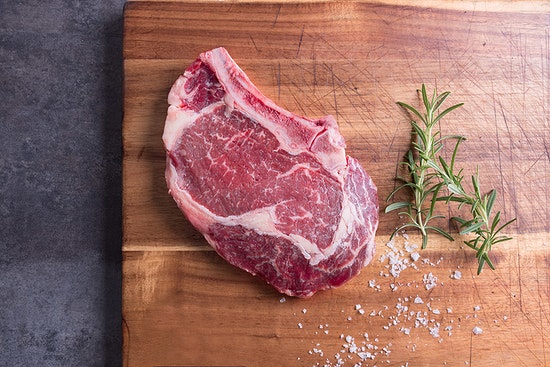
Ribeyes are sometimes cut to contain different sets of muscles, so they vary in texture with a mixture of tough and tender meat. The marbling is an intricate and beautiful pattern of fat and connective tissue that gives the cut excellent, juicy flavor.
Many steak lovers swear by the ribeye because it’s slightly cheaper than the New York strip but still has a rich, robust flavor. Find the Ribeye Steak Here!
Bone-in Ribeye Steaks are a luxurious cut of meat that comes from the rib loin section of the cow. These steaks are 100% grass-fed and pasture-raised, making them packed with vitamins A, B, and E.
Appearance
This cut is generally between 8 and 12 ounces. It should be between one and 1.5 inches thick. The fat and connective tissue that’s marbled throughout adds a lot of flavor. When it’s cooked properly, it’s not hard to chew, although it is tougher than very tender cuts like filet mignon.
In addition to the marbling, you will see white spots of fat throughout as well as thick strips of fat on all the edges.
Texture
While the fat content in a ribeye can make it tougher than very tender cuts, it’s intensely flavorful and juicy. When it’s cooked to perfection, it can be very tender and very soft. It’s not as tough as a New York strip, but not as velvety as a filet mignon.
Taste
The taste of ribeye is dominant and meaty. This is a highly exercised muscle, developing much more taste than tender, unused muscles. This rich, fleshy taste will overpower almost anything else on the plate.
You can pair this cut with something flavorful, as long as the flavors complement one another.
Cost
The ribeye isn’t the cheapest cut, but it offers a good value. It’s a great balance between cost and flavor, offering something that’s forgiving to cook, even if you overcook it just a bit. You’ll get your money’s worth here.
Portion size
Because of its rich and hearty flavor, a 6-ounce portion is often enough for most. However, common serving sizes range from 8 to 12 ounces. It’s filling and doesn’t need a lot on the side. You’ll be happy with small portions of green beans or potatoes and a glass of red wine.
Grilling prep
The ideal thickness for a ribeye is 1.25 to 1.5 inches for a good mouthfeel and to maintain flavor while grilling. Don’t trim the fat unless there are large protrusions that may flare up or char.
Remove your steak from the refrigerator at least 30 minutes before grilling. If you can, let it sit for 60 to take off the chill and allow for more even cooking.
Sprinkle with salt and pepper to enhance its natural flavor. If you want to add something extra, opt for a dry rub rather than a marinade.
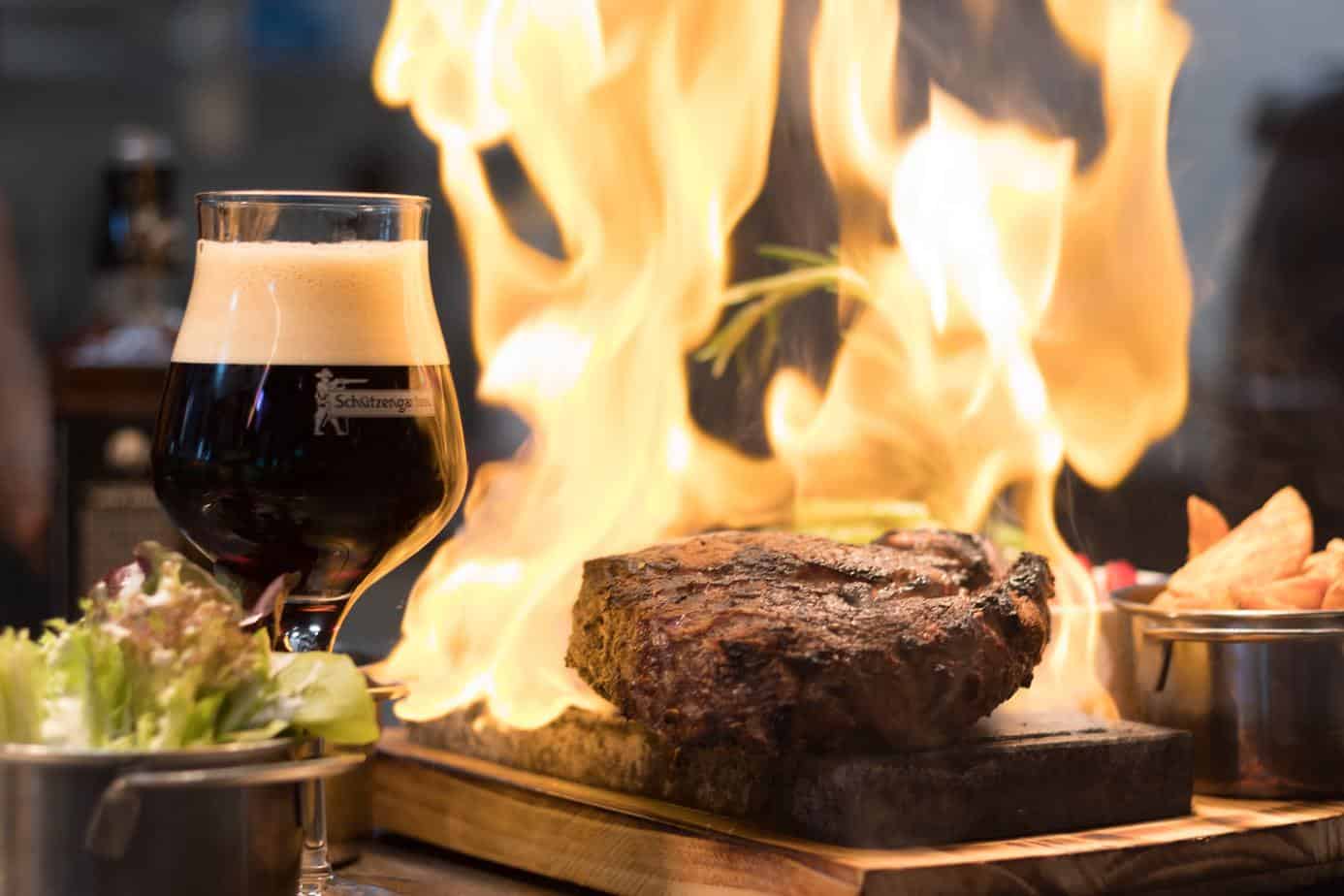
Cooking a ribeye
Using a two-zone cooking space, heat one burner or side of your grill to medium-high heat. Once it’s warm, place your steak directly over the heat and sear for 4-5 minutes on each side. If you like your steaks medium-rare, you can remove it immediately.
However, if you enjoy less pink, you can move your steak over to the cooler side of the grill and finish cooking here. Remember that carryover cooking will continue to remove the pink for 5-10 minutes after removing your steak from the grill.
Fat can catch fire very quickly, so ribeyes need to be monitored closely for flare-ups.
Pros:
- Hearty and flavorful
- Inexpensive
Cons:
- Flares up easily
- Can be chewy and fatty
Comparison Chart
| New York Strip | Ribeye | |
| Size | Medium to large | Medium to large |
| Meat content | Very high | High |
| Fat content | Low | Moderate to high |
| Weight | 8-16 ounces | 8-12 ounces |
| Servings per cut | 2 | 2 |
| Location on cow | Lower central ribs | Upper central ribs |
| Calories (3oz serving) | 183 | 170 |
| Saturated fat (3oz serving) | 5 grams | 2.8 grams |
| Protein (3oz serving) | 17 grams | 26 grams |
FAQ
If you still have questions about the differences between New York strips and ribeyes, here are some frequently asked questions to help you decide which you might like better.
You’ll likely find that the New York strip is slightly more expensive than the ribeye. They both look very similar, but the New York strip is a higher quality cut. It’s a healthier steak when taking into account the fat content. It can be chewier, but some people also like the flavor better.
If you were standing in the meat section of your grocery store thinking ribeye and New York strip were expensive, think again. Japanese Kobe steak is the world’s most expensive meat. Prices vary based on location, but it’s known to have some of the best marbling and flavor you can get in a piece of steak.
That New York strip doesn’t look so bad now, does it?
This is all subject to your experience and interpretation, but there are several very tender cuts of steak. You can likely rule out the New York strip almost immediately. While it’s very healthy and has a ton of flavor, it also tends to be tougher than other cuts.
Ribeye, on the other hand, is a surprisingly tender cut. While it’s not nearly as tender as a tenderloin or a filet mignon, a lot of people like the ribeye better, simply because it balances texture with flavor and has the best of both worlds.
Which is Best?
You can’t possibly decide which is best without trying them both first. If you’re partial to tender cuts of meat, you’ll definitely love the ribeye. Plus, it’s beautiful marbling creates the perfect cut for grilling. It’s forgiving, and you can’t ruin it unless you’re really trying.
Bone-in Ribeye Steaks are a luxurious cut of meat that comes from the rib loin section of the cow. These steaks are 100% grass-fed and pasture-raised, making them packed with vitamins A, B, and E.
However, if you like flavor, it’s a toss-up. Both have excellent flavor. While the ribeye tends to be juicier, it has a more robust, natural flavor that’s true to its meaty nature. The New York strip is more savory.
Looking for a luxurious steak dinner? Look no further than our New York Strip Steak. This cut comes from the top of the striploin and is known for its intense flavor and tender texture.


